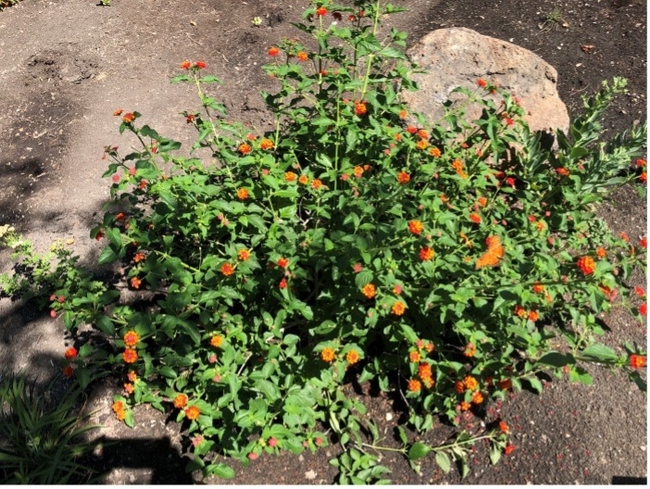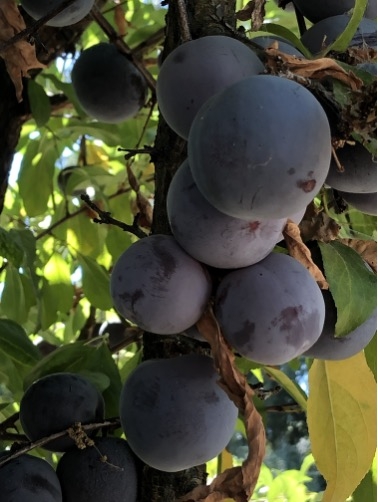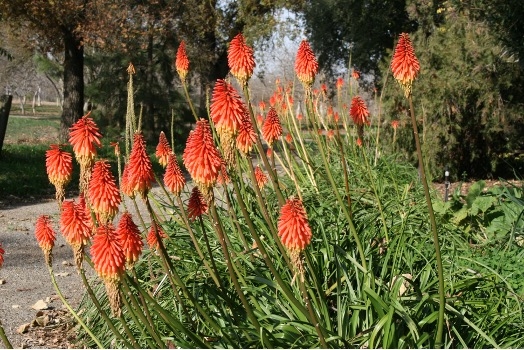Plants to Enjoy
Lantana, the Laroda plum tree, and Red Hot Poker are just a few of my favorite plants in my ¾-acre garden.
SHRUB: Although there are 150 different species of lantana, those most widely available to home gardeners are Lantana camara and modern hybrids. A member of the verbena family, lantana is native to tropical regions of the Americas and South Africa. This small tropical shrub has lots of small flower clusters that come in a rainbow of single and multiple hues. It is perennial in climate zones 9 to 11 and can be an annual in colder climates unless it is brought inside in the fall. In our zone 9, it blooms nearly year around. The flowers attract butterflies, hummingbirds, and insect pollinators.
It can be pruned back in the spring by one third. It thrives in hot, dry weather and does best in 6 to 8 hours of full sun. It tolerates various soils but does best in rich, well-drained soil. It is usually a short 2- to 3-foot shrub but can reach 6 feet tall and 3 to 10 feet wide. While it can be grown in containers, I recently moved a container-grown plant into the ground, where it grew much larger and bloomed more vigorously. I have another container-grown one that I will plant in the ground soon because the results of the first one were so impressive. I have since bought four more to add to my collection.
TREE: The Laroda plum has an extraordinary wine-like flavor and is considered by some to be one of the best tasting Japanese plums. The flesh is amber with streaks of red on the inside. The texture is firm with high sweetness, balanced with just the right amount of acidity. It has received high overall scores in taste testings for its sweet, excellent flavor. A dark purple plum similar to the Santa Rosa,Laroda is larger and ripens about a month later and has a long harvest, which begins in mid-July and extends into mid-August. Unlike Santa Rosa plums, Laroda plums tend to stay on the tree even after ripening, which extends harvest time. The tree is vigorous and upright. This mid-season bloomer requires a pollinizer such as Santa Rosa or Catalina. When I moved to my new home in 2017, I grafted a flowering plum and a rootstock sprout to Laroda and Elephant Heart plums. The Elephant Heart grafts failed and and so I now have two trees that produce baskets of Laroda plums beyond belief.
PERENNIAL FLOWER: Red Hot Poker (Kniphofia) is a genus of about 70 species of evergreen or herbaceous perennials prized for their tall, show-stopping flower spikes in bright red, orange, and yellow. The evergreen species feature linear, strap-shaped, basal leaves and showy bottlebrush-like flower spikes. The herbaceous species have narrow, grass-like leaves. The genus is native to mountainous areas in southern to tropical Africa. Plant size ranges from dwarf to 1-1/2 feet tall, with some species reaching 6 feet tall. The genus name honors Johann Hieronymus Kniphof (1704-1763), a German physician and botanist.
Red Hot Poker prefers a rich, well-drained, moist soil in full sun. Light shade is helpful if summers are hot, and the plant should be sited in a location protected from wind. It will do well in sandy soils but is less tolerate of clay. When flowers fade, simply cut them away from the stem with garden shears about one-half inch below the flowers. This plant is slightly salt tolerant. It is attractive to hummingbirds, bees, and butterflies but, fortunately, not to deer or rabbits. Plants can be propagated by seed, or, for named cultivars, by division in the spring. See this website for more information on growing and managing this plant.


